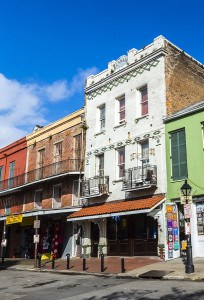

The collapse of a 210-year-old building in the heart of New Orleans’ French Quarter is raising warning flags about decay and a lack of rigorous inspections in one of America’s oldest and most fragile neighborhoods.
No one was injured when the three-story, brick-and-cypress building collapsed in late October, but the episode has thrown into focus an array of problems throughout the nearly 300-year-old Quarter. Among them: structural decay, voracious termites at work on aged wood beams, Louisiana’s humid climate, absentee landlords and the stresses of modern life as heavy trucks rattle streets and balconied buildings standing shoulder to shoulder.

Perhaps the biggest problem, though, is that no one is charged with making sure the Quarter’s 3,000 old buildings are stable. And the city has no in-depth inspection policy tailored to the distinct qualities of its first neighborhood.
The single inspector at the Vieux Carre Commission, the city’s zoning arm for the Quarter, only has authority to inspect a building’s exterior. Citations are routine for gaudy signs and Plexiglas – violations of historical standards – or letting a facade decay. Owners can’t be cited for letting a floor sag or allowing mortar to deteriorate to dust on the interiors of their buildings. There are city building and fire inspectors, but they do not do random inspections of old structures.
The commission’s check-ups amount to “a visual inspection that occurs from the streets, corners, and any aerial views that we are readily afforded,” said commission chairman Nicholas Musso. “We do not have the ability to enter a piece of property, or a courtyard, or a rear of a building. It could have been crucial in this particular instance.”
Even based on superficial assessments, he’s concerned about the condition of some structures: “We do have a series of buildings that are highly suspect, should we say.”
Though many residents and preservationists deem the collapse a wake-up call, longtime Quarter real estate agent Michael Wilkinson thinks the steady rise of wealthier owners ensures most properties are being looked after. Property values have increased by as much as 30 percent in recent years.
“There’s a lot of incentive – financial and otherwise – to maintain these properties,” Wilkinson said. “It’s a very wealthy area.”
For now, Musso said, the commission hopes property owners will take the initiative and ask inspectors to come in and take a look around.
It’s not as though there are no interior inspections. Fire department and city inspectors routinely examine commercial properties – the myriad of crowded bars and restaurants that make the Quarter so appealing to the 9.2 million tourists who visited New Orleans last year. Building inspectors weigh in whenever major renovations are done to commercial or residential property. And banks require a building to be inspected before backing a purchase.
When it comes to inspections and enforcing good maintenance, New Orleans’ rules don’t differ much from most historic cities and towns, said John Hildreth, a regional vice president for the National Trust for Historic Preservation. Regulations in Boston and New York, for instance, largely match those in New Orleans.
Ultimately, that means most of the older structures aren’t undergoing regular reviews.
The collapse near the heart of the Quarter came at lunchtime on a Tuesday on a block of Royal Street lined with high-end art galleries, boutiques, jewelry stores and restaurants. Renters in the fallen building, one of the earliest three-story structures in the Quarter, were not at home when it caved in.
‘Incredibly, no one got killed,” said Peter Trapolin, an architect who regularly works in the Quarter and who believes the neighborhood needs a stronger inspection protocol.
The owners of the building were cited in 2011 for allowing the facade to decay, but the Vieux Carre Commission has said no single problem caused the collapse.
The elderly lady who owned the building operated a small shop where she cut keys and made second-line umbrellas, the decorative parasols common in jazz processions, until about two years ago, said Doc Hawley, an amateur neighborhood historian and a well-known figure around the Quarter for his decades as the captain of the Natchez steamboat. He said the building’s old timbers had been badly damaged by termites.
“These buildings were built for horse and buggies,” Hawley said. “I lie in bed and I feel my house (in the Quarter) go up and down. The pictures on my walls bounce up and down when the big trucks go by outside.”